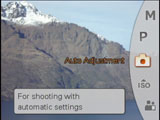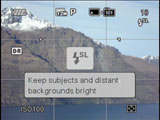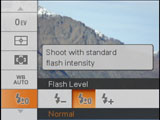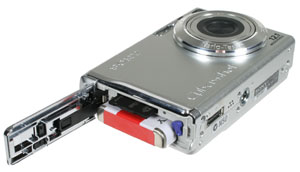Sony Cyber-shot DSC-W200
-
-
Written by Gordon Laing
Sony Cyber-shot DSC-W200 design and build quality
Sony’s Cyber-shot DSC-W200 is a smart-looking, metal-bodied compact with a brushed front surface and cross-hatched lettering which catch the light in a classy way. We’ve pictured it below on the left, alongside the equally classy Panasonic Lumix DMC-FX30, a slim 7.2 Megapixel compact. Measuring 91x59x22mm, the W200’s main body shares the same thickness as the FX30, although its lens housing protrudes further by 5mm compared to the FX30’s 1.5mm. Otherwise the W200 is 4mm narrower and 7mm taller.
You never expect much of a grip on a slim compact, but the W200 has less than most. Unlike the horizontal ridge on the front of the FX30 and many other compacts, there’s nothing for your middle finger to press against, and unless you count the zoom rocker on the back, little for your thumb to rest on either. There is a slight ridge on the far right side which can be gripped a little, but it’s harder to hold the W200 steadily with one hand than, say, the FX30; that’s the price you pay for the stylish, uncluttered front panel. To be fair, it’s not actually that bad, but there are certainly compacts which are easier to hold.
Like Sony’s other premium compacts, the build quality is excellent with smooth and careful joins and no creaks to worry about. It weighs 116g without its battery, which along with the 22mm thickness means it’ll slip discreetly into most pockets. If you’d like protect it from snow, rain or sand, or indeed dive into the Sea as a different kind of snapper, the optional MPK-WB Marine Pack will protect the W200 from dust, moisture and underwater depths of up to 40m; there’s even an optional HVL-ML20M Underwater Video Light accessory.
 |
 |
 |
The W200’s top surface features little more than the microphone, an illuminated power button and a rectangular shutter release. The bulk of the controls can be found on the rear surface to the right of the colour screen. From top to bottom are a zoom rocker, mode dial and a traditional four-way joypad control, along with Play, Menu and Home buttons
The mode dial features ten positions: Automatic, Program Auto, Manual and Movie mode, along with direct access to five scene presets and a SCN position which allows you to access a further four presets. While the W200 doesn’t feature the myriad of often ambiguous scene presets of other compacts, it’s a relief to find a full manual mode which actually lets you adjust aperture and shutter speed – more of which later. Switching between exposure modes is also replicated graphically on-screen as you turn the dial.
 |
 |
Pushing the four-way joypad controller down selects a 2 or 10 second self-timer, pushing left switches the macro mode on and off, pushing up switches the display options (see Features pages), while pushing right cycles through the Flash modes: Auto, Always On, Slow Syncro and Forced Off.
There’s additionally flash level options. Pressing the button in the middle of the four-way group confirms the action in menus. Finally, the separate Play and Menu buttons are self-explanatory, while pressing the Home button takes you to a page where you can access all of the W200’s settings – see Features section.
While the W200 has a built-in flash, there’s also an optional HVL-RLS ring-light accessory which uses white LEDs to better illuminate close-up subjects in macro mode. Along with the optional underwater housing, component HD video cable and lens extenders, you certainly can’t fault the W200 on the accessory front. We’ll discuss the screen and viewfinder in our Features section.
Sony Cyber-shot DSC-W200 connectivity and battery
 |
A door on the right side of the W200 opens to reveal the battery compartment and memory card slot – for Sony Memory Stick Duos of course. It’s good to find access to these at the side though as it allows you to change either while the camera’s mounted on a tripod – and speaking of which the tripod thread itself is sensibly located in the middle of the body’s underside as oppose to many compacts which position it near the edge almost as an after-thought.
So far so good, but where the W200 lets you down in typical Sony style is when it comes to getting your pictures off the camera. Rather than use standard AV and USB sockets for cheap and easily replaceable cables, the W200 employs a proprietary connector on its underside and comes with a cable which ends in AV and USB plugs.
This port can also be used to connect the optional VMC-MHC1 component video cable for HDTV slideshows, or to dock in the CSS-HD1 Cyber-shot station. Sure it all works fine in an all-Sony world, but we prefer not to be tied to proprietary connectors for the basic outputs – and even when you have the supplied AV / USB cable connected, the camera needs to be lying down in what looks like a slightly uncomfortable position.
The W200 is powered by an NP-BG1 Lithium Ion pack which Sony claims is good for up to 270 shots. We managed around 150 on a single charge, although this did include several with the flash under freezing outdoor temperatures. A recharger is supplied, but if you’re in a hurry, you might want to upgrade to the optional BC-TRG Compact Battery Charger which is both smaller and capable of doing the job three times faster. There’s also an optional AC-LS5K AC adapter, although this also requires the VMC-MD1 Multi Use Terminal Cable. Can there be an accessory Sony’s not thought of?




